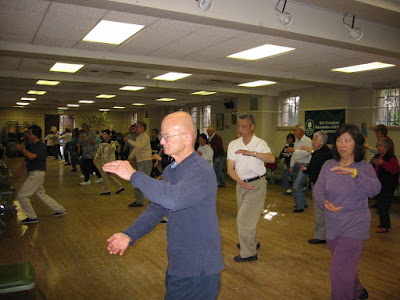 |
| Tai chi in Golden Gate Park Senior Centre, San Francisco |
I
watched with wonder as if in a trance!
Is
it the art of self-defence or a slow-motion dance?
It
is Tai chi, a gentle graceful workout
For
the mind and body, an exercise to warm your heart.
Tai chi, an exercise
synonymous with “hitting mosquitoes in slow motion”, fascinated me many years
ago. After learning the simplified 18 and 24 Forms from an instructor, I
continued to practise at home with the help of a video compact disc.
In Malaysia,
many seniors have been doing tai chi (taiji)
for a very long time, either in the open field or in enclosed buildings. It
is conducted in Mandarin, to slow classical music, and each Form has a specific
name. I thought that it was the same in any part of the world. How wrong I was!
Recently, I
visited the Golden Gate Park Senior Centre at Fulton Street in San Francisco,
United States, and decided to join the tai chi classes. Arriving early in the
hall, I was taken aback - about 40 participants, in four rows, were doing tai
chi in total silence. Except for the squelch of shoes during pivotal turns, you
could hear a pin drop!
I noticed that
many of the formations were familiar. My new found friend, Mr. Hui, invited me
to join in, so I sportingly complied. I felt good, moving together with the
group and feeling my perspiration trickle down my brow.
Someone called
out single whip and as we did the
formation, I recognized it as dan bian
in Mandarin. Thereafter, I learnt other mesmerizing English equivalents. Wow,
tai chi in English!
When the sifu Garett Chinn arrived, he went
around quietly, correcting certain postures and reinforcing some of the
formations. After the exercise, Chinn spoke to the whole group.
“Keep your
knees bent - those who cannot do this can stand straight. Relax and shift your
weight to your left,” he demonstrated. “Every movement must be in balance and
coordinated: when you move your left knee forward, you need to move your right
wrist at the same time, in harmony. Ensure that the opposing forces work
together.”
 |
| Sifu Garret Chinn leading the participants |
Later, after
the session, I chatted with the youthful Chinn, who also teaches in the City
College of San Francisco. He has been teaching tai chi for the past 20 years.
When I told him I was from Malaysia and we do tai chi with music, he was
amused.
“We do not need
music,” Chinn said. The tai chi taught by Chinn was Prof. Cheng Man-ching’s Short Yang Form consisting of 37
postures. Chinn had studied under Prof. Cheng’s first disciple, Benjamin
Pang-jeng Lo in 1977. The latter was a classmate of Huang Shen-shun, a
Malaysian.
I then talked
to the students to get some feedback on their tai chi workouts.
Andrew Hom, 76,
told me that he had tried many exercises before but none of them lasted. “With
tai chi, it’s different. I continue to do it and like it very much. I exercise
here two times a week and I’ve never felt better. It’s good for the mind too as
I feel more alert.”
Johnny, 58,
said that doing tai chi with the others was like doing it with his brothers and
sisters. “To improve, you really need to practise,” he said enthusiastically.
“I do it so often that sometimes I even do it in my dreams!”
Tony, 53, with
three years of tai chi, elaborated: “I enjoy every minute of it. Initially when
Chinn asked us to bend our knees, it was real torture. It looks easy but it is
not. I have many friends who are great basketball players but they find it
difficult to bend their knees too. Before tai chi, standing on one leg was
difficult, but now I can do it very well.”
Phyllis
Greenblatt, 71, has been doing tai chi for eight years. She found it very
difficult at first. “After one year, my bone density has improved and my cholesterol
level has come down. After 3 years, I thought I knew it well, but I still need
to be corrected in some of the Forms. Generally, I feel healthier and my
balance and control have improved,” she volunteered.
Judi Tsuyuki,
64, had osteoporosis and her legs and hips were weak. “But after tai chi, I can walk for hours without any
problems. I wish I had started earlier, but it is better late than never!”
“It’s great for
the elderly. Because we don’t move much, the slow exercise is suitable for us,”
informed Monica Widburg, 81. “Tai chi gives me better balance. My backache is
less now, and my body feels relaxed.”
Johnny, 76,
opined, “Tai chi keeps me young and active. A lot of doctors recommend it.”
Jenny, 75,
enjoyed the socialising part. “I can exercise and meet friends at the same
time,” she said cheerfully.
There was one
admirable couple whose names were on everyone’s lips. This special ‘young and
happy’ couple - Elsie and William Chan, 88 - have been doing tai chi
continuously for five years. A picture of health and youthful exuberance, they
spontaneously echoed, “We love the exercise – it is so relaxing!”
Tai chi means supreme energy (chi/ji) and after a session, one feels revitalised and full of energy. In Malaysia, many people do tai chi and there are many forms, from 18, 24, 44 to even more than 100. Some do tai chi while holding a fan, a
sword or a staff. No matter how many Forms,
with or without music, tai chi will remain an evergreen exercise.
...........................................................................................................................
This article was published in the Star (Malaysian newspaper) on May 5, 2005.
More photos are added here.



No comments:
Post a Comment